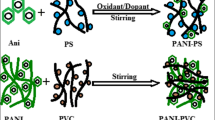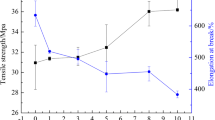Abstract
Films made of a blend of polyaniline (PAni) and a nonpolar polyvinylidene fluoride (PVDF) polymer matrix were obtained by the mechanical mixing of both, with subsequent melting and quenching. Using the current versus voltage (IxV) measurements, the percolation threshold (concentration in which some conducting particles are connected to form at least one conductor path, related to one direction of the film) was determined to be between 40 and 45 % in volume along the surface. Related to the film thickness, a small amount of PAni (0.5 % in volume) was enough to transform the blend in a conducting material. Strain–stress tests indicated that a small amount of PAni can reinforce the polymer matrix. Furthermore, the immiscible blend obtained changes in its electrical conductivity, according to the pH of the solution in which it was immersed, indicating the possibility of the real application of that material as a resistor with variable electrical resistance.







Similar content being viewed by others
References
Strümpler RD, Glatz-Reichenbach J (1999) Conducting polymer composites. J Electroceram 3(4):329–346
Wang HL, Fernandez JE (1992) Conducting polymer blends: polypyrrole and poly(vinyl methyl ketone). Macromolecules 25(23):6179–6184
Bunde A, Dieterich W (2000) Percolation in composites. J Electroceramics, Dordr 5(2):81–92
Macdiarmid AG, Chiang JC, Richter AF (1987) Polyaniline: a new concept in conducting polymers. Synth Met, Lausanne 18(1–3):285–290
Lovinger AJ (1982) Developments in crystalline polymers-1. Applied Science Publishers, London, pp 195–273
Erdtman E, Satyanarayana KC, Bolton K (2012) Simulation of α- and β-PVDF melting mechanisms. Polymer 53:2919–2926
Nicolas-Debarnot D, Poncin-Epaillard F (2003) Polyaniline as a new sensitive layer for gas sensors. Anal Chim Acta 475:1–15
Xiea G, Suna P, Yana X, Dua X, Jianga Y (2010) Fabrication of methane gas sensor by layer-by-layer self-assembly of polyaniline/PdO ultra thin films on quartz crystal microbalance. Sens and Actuators B 145:373–377
Mattoso LHC, MacDiarmid AG, Epstein AJ (1994) Controlled synthesis of high molecular weight polyaniline and poly (o-methoxyaniline). Synth Met 68(1):1–11
Moulton SE et al (2004) Polymerisation and characterisation of conducting polyaniline nanoparticle dispersions. Curr Appl Phys, Amst 4(4):402–406
Abdiryim T, Xiao-Gang Z, Jamal R (2005) Comparative studies of solid-state synthesized polyaniline doped with inorganic acids. Mater Chem Phys, Lausanne 90(2–3):367–372
Zulfiqar S, Zulfiqar M, Munir A (1994) Study of the thermal-degradation of polychlorotrifluoroethylene, poly(vinylidene fluoride) and copolymers of chlorotrifluoroethylene and vinylidene fluoride. Polym Degrad Stab, Oxon 43(3):423–430
Afzal AB, Akhtar MJ, Ahmad M (2010) Morphological studies of DBSA-doped polyaniline/PVC blends. J Electron Microsc, Tokyo 59(5):339–344
Soares BG, Celestino ML, Magioli M, Moreira VX, Khastgir D (2010) Synthesis of conductive adhesives based on epoxy resin and polyaniline. DBSA using the in situ polymerization and physical mixing procedures. Synth Met, Lausanne 160(1):1981–1986
Silva MJ, Sanches AO, Malmonge LF, Malmonge JA (2014) Electrical, mechanical, and thermal analysis of natural rubber/polyaniline-Dbsa composite. Mater Resh, São Carlos 17(1):59–63
Shaw MT, Macknight WJ (2005) Introduction to polymer viscoelasticity, 3rd edn. Wiley, New Jersey
Malmonge LF, Langiano SC, Cordeiro JMM, Mattoso LHC, Malmonge JA (2010) Thermal and mechanical properties of PVDF/PANI Blends. Mater Res 13(4):465–470
Fu SY, Feng XQ, Lauke B, Mai YW (2008) Effects of particle size, particle/matrix interface adhesion and particle loading on mechanical properties of particulate–polymer composites. Compos B 39:933–961
Callister WD, Rethwisch WG (2010) Materials science and engineering. Wiley, New Jersey
Acknowledgments
The authors express their gratitude to Fundação de Amparo à Pesquisa do Estado de Mato Grosso (FAPEMAT), Fundação de Amparo à Pesquisa de São Paulo—FAPESP (CEPID 2013/07296-2) for financial support.
Author information
Authors and Affiliations
Corresponding author
Rights and permissions
About this article
Cite this article
Sousa, E.A., Deniz, W.D.S., Arlindo, E.P.S. et al. PVDF-PAni blend: a free-standing film with variable electrical resistance. Polym. Bull. 74, 1483–1492 (2017). https://doi.org/10.1007/s00289-016-1785-1
Received:
Revised:
Accepted:
Published:
Issue Date:
DOI: https://doi.org/10.1007/s00289-016-1785-1




